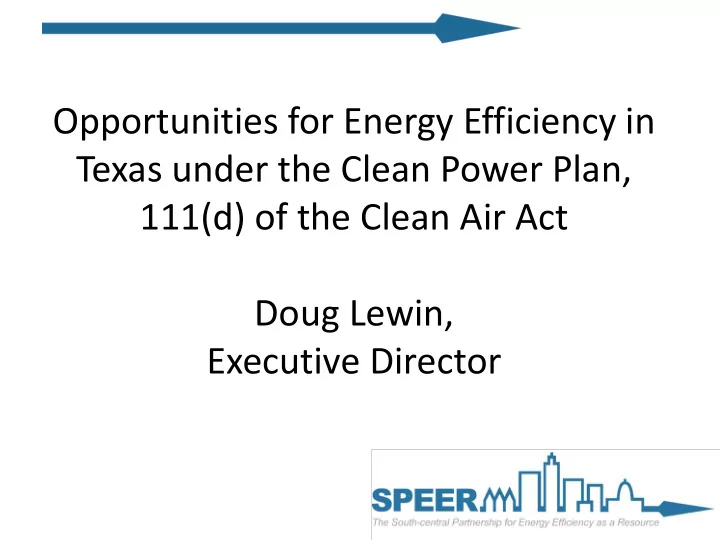

Opportunities for Energy Efficiency in Texas under the Clean Power Plan, 111(d) of the Clean Air Act Doug Lewin, Executive Director
EPA’s 2030 State Goal Calculation for Texas BB2 (Redispatch coal): BB3 (Renewables, Wind): BB4 (Energy Efficiency): Required reduction: (283 ÷ 629) = EPA ramps at ~8%/yr; but (70 ÷ 629 = 11%) (1420 – 791) = 629 45% of requirement Texas 1999-2013 = ~23%/yr! But could we do more? Maintain wind growth and/or boost Maintain Texas’ 3x pace => Include codes, CHP, EE could allow Texas to reach (~3 x 214) = 615, PACE, WHEEL, etc? compliance quicker and easier. 98% of requirement Source: Regulatory Assistance Project
Texas under the Clean Power Plan EPA Baseline Interim Rate Final Rate % Change 2012 2020-2029 2030 Calculated 1298 lbs/MWh 853 lbs/MWh 791lbs/MWh -39% Emissions Rate How do we get there according to the EPA’s Building Blocks? 1. 6% heat rate improvement at coal plants. 2. Increase of natural gas usage by 56%, or about 3% per year. 3. Increase of renewables by 6% per year. • Wind has grown at 23% per year over last 15 years. • CREZ lines alone will allow us to meet half of the increase in building block 3. 4. Increase in energy efficiency from .19% of retail sales to 1.5% of retail sales, or overall reduction of 10% by 2030 compared to 3%.
Texas stands to gain from the CPP as fuel switching leads to increases in natural gas
Energy Efficiency in CPP CPP Building Block 4 suggests a goal of 1.5% energy savings, slightly above the US average. Texas is currently at .19%.
With EE, electric bills go down. Electric rates go up higher with energy Without it, bills go up. efficiency as efficiency programs are expanded. But electric bills go down because consumers are buying less electricity. Without EE, rates rise slightly less, but total bills increase . Source: Center for Strategic and 9 International Studies and Rhodium Group
Texas’ rates are average. But total bills are significan tly higher. Source: Public Utility Commission of Texas 10 Strategic Plan.
Source: Brattle Group Note: EPA’s 10% is over 15 years, while Itron’s 7% was over 10 years.
Why Would EE Reduce Costs of Compliance? According to PUCT’s Official M&V Report: • For every $1 in spending for EE, more than $3.40 in savings. • Average cost of avoided kWh is less than 1.8 cents, far lower than the cheapest electricity. • Programs in 2013 saved over 577,000 MWh. Also saved over 450 MW. Source: Public Utility Commission of Texas. “Annual Statewide Portfolio Report for Program Year 2013—Volume I(Draft).” June 30, 2014, revised September 2014. Project Number 40891
Conclusions • Efficiency programs in Texas are highly cost effective, according to PUCT’s M&V report. • Complying with 111(d) without EE would cost more, according to CSIS/Rhodium Group. • EE goal suggested in draft rule is achievable, according to potential studies by Itron, ACEEE, Brattle, and DNV- Kema. • 10% reduction in total sales from EE equals a reduction in overall electricity expenditures by a net of $2-$5 billion annually. • Efficiency reduces bills for all customers, including non- participants.
Recommend
More recommend